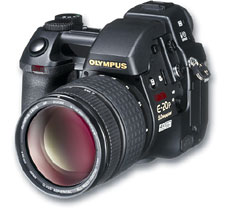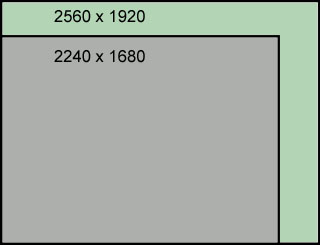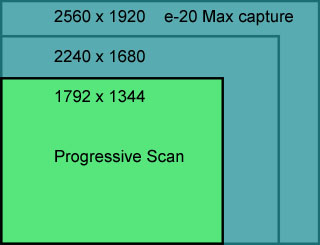 |
You have probably already read the specs of
the new
Olympus digital SLR E-20 camera,
all the cool stuff, 5 megapixels, faster shutter speeds and
so on. But what does it really mean in real life everyday use
of the camera?
|

Resolution.
Lets start with the most visible update. 2560x 1920 means more dots
which delivers bigger sharper prints. With a Photoshop file size
of 14.4 megabytes, the e-20 produces a 245 dpi 8x10 compared to the
e-10 which delivers a 8x10 at 210 dpi. Not much..? If you were to make
a 16x20 print the e-20 would give you about 120 dpi. compared to about
105 dpi from the e-10, this is a more important difference, since it
makes for a hugely better quality of the large print.
Storage.
Olympus have chosen to put the same two slots in the camera as before,
but unlike the e-10 the e-20 now officially supports the IBM MicroDrives,
all the way to 1 gig. This is important because it means cheap storage
for your high resolution images.
White Balance.
Everything is as with the e-10, the e-20 will allow you to chose a appropriate
color from the most blue of moments to the reddest tungsten light. Personally
I find 5500k works wonderfully in daylight... But hey. More options
is better.
Manual options: 3000, 3700, 4000, 4500, 5500, 6500 and 7500 °K
Some people prefer the auto white option, I do not care much for the
automatic selections myself.
ASA.settings.
Same as before, you can choose between 80 asa, 160 asa and 320 asa.
Image Quality.
This is a important point, the few images I have seen from beta cameras
suggest that the noise in the pixels are the same or less than what
you would experience with the e-10. along with the higher resolution,
it will deliver smoother final prints. Personally I'm quite convinced
that the shipping version of the e-20 will have less noise in the image
than what was the case with the e-10, simply because of the time since
the e-10 camera came out. Technology have improved, and it is hard to
imagine that this improvement would not also affect the image quality.
Olympus
beta E-20 gallery
Single
highrez Olympus beta E-20 image
Active Noise Cancelation.
The new e-20 camera also incoperates a very cool active noise cancelation
technology when taking time exposures. In effect it takes a picture
with the shutter closed, this should be a entirely black image, however
noise from the chip will show up in this image, this camera then substracts
this image from the time exposure capture, the result is a significant
reduction in the overall noise of the final image.
This feature is selectable in the main menu, and is only recomended
when photograhing time exposures, as it takes almost 1 minute to process
the image after the shutter closes. However if you are looking for great
quality images at long exposure times. The E20 is probably the best
choice around right now.
Lens.
Olympus 4x zoom lens, 9 – 36 mm F2.0-2.4, all glass zoom lens with
one ED and two aspherical lens elements (14 elements in 11 groups).
This is practically the same lens as what was on the e-10, it also have
a 62mm filter tread. Other than I had hoped Olympus would have put a
longer zoom on the new camera. This is a perfect lens, and have proven
to be reliable and tack sharp. It compares to a 35-140mm on a regular
35mm camera.
More importantly, the choice of lens, also means that you can use any
accessory lenses you might have purchased for the e-10, or you can purchase
used e-10 lenses for your e-20. I feel this is very important for people
who use a camera professionally, since the investment in extra lenses
is almost as big as the camera itself.
Progressive mode.... What is this..?
Well, this is a interesting way of not reading all of the pixels on
the chip, the result seems to be that the e-20 is able to deliver some
astonishing shutter speeds as high as 1/18.000th (That's really FAST
Folks). But the drawback is that the resolution is reduced to about
half as many active pixels 1,792 X 1,344

This is where things gets a little sketchy. Because if
you got the idea of making a 8x10 print from a progressive scan capture.
Well suddenly you would have a 168dpi print, while this is still enough
to pass as a photograph... At best there are not much room left for
cropping.
Now, WHY did Olympus choose to put this funny value e-20 digital SLR..?
My guess would be that this is a great shot at the sports market, until
now the e-10's biggest drawback was its limited shutter speed. 1/640th
just did not put a smile on the face of a lot of sports shooters, so
they did instead pick up something like a Nikon D1, which clearly is
a accepted professional camera by lots of newspapers across the country,
you do not have to flip many pages in a newspaper to find the telltale
look of a D1 camera's digital images. Interestingly enough, it just
so happens that the D-10 have a image size of 2000x1300 pixels, when
printing a 8x10 that comes out to 162 dpi. Shooting in the Progressive
mode it is also possible to capture 4.5 frames per sec up to 7 exposures
before the buffer is full, this is very respectable for sports photography.
The drawback here is that it still take a lot of time to put these frames
away, about 4sec each. multiply with 7 frames in buffer, the good news
is that the E20 allows you to continue photograhing more frames as soon
as buffer space are available.
The e-20 Sports Camera
It seems to me that Olympus have delivered a very nice sports camera,
with shutter speeds all the way up to 1/18.000th with a image quality
matching that of the already established Nikon D1. Not bad in a sub
$2000 package which also can deliver 5 megapixels for high resolution
print work, such as weddings and portraiture photography. From my perspective,
the only real issue with the e-20 as a sports camera is that the zoom
is a bit short, traditionally the 80-200mm zoom seems to the be favorite
lens for lots of sports, this is a range the shooters as used to zoom,
after that they jump to a 300mm. It would be nice to see a zoom-through
add on lens allowing sports shooters to zoom up to about 200+mm.
Though, that said, I must say that I do feel that the camera clears
the files out of buffer to slowly to really be a comfortable sports
camera...
Speed
Over all operating speed of the Olympus e-20 digital SLR have increased
but not as much as I had hoped for. The camera handles larger files
than the E10, but it takes almost as long time to put them away, I'm
guessing that the Olympus TruePic feature which is part of creating
smooth graduations may be consuming a lot of processor power. Personally
I would vote for a feature to turn off whatever slows me down and let
me work faster when needed.
Hardware Changes?
Olympus mentioned in the press release that the body have been updated
based on feedback from photographers. Well, I looked high and low, to
me it looks like a E-10 body with new badges... UNTIL I found it. The
exposure compensation button have recieved a raised edge around the
lower half to prevent people from pressing the compensation button while
working with the camera. Not much, but positively a change of hardware..
(smile)
What is missing from the picture?
Well there are a couple of things I really would have liked to see in
this camera.
Auto Bracket in Manual mode is still missing.
Selectable number of frames in auto bracket.
Instant capture using the IR remote control.
Less than 1 minute increments for the time-lapse mode.
The camera monitor can still not fold much downwards, making it hard
to capture images overhead.
Olympus still need to come out with a serious wide-angle add on lens,
something like 18mm
Is it worth upgrading from the e-10 to the e-20?
Well naturally that depends what you do with your camera... The Olympus
e-10 is still a very serious and capable camera. However if you make
your living with your camera, YES, positively, the Olympus e-20 delivers
lots of great features which have been missing in the e-10, including
higher resolution and better image quality. While still being compatible
with the stuff you already purchased for your e-10.
That said.... I'm currently making my living with a Olympus Camedia
E-10, and it delivers wonderful images which my clients are 100% pleased
with. This camera is everything most people will ever need from a digital
camera. If you have one already or have your hands on one at a great
prize, and need a solid prosumer camera, get it. Upgrading is a search
for more pixels and a few features, however the E-10 are likely to meet
all of your needs.
For refference, I have added a Olympus Camedia E-20 to my toolbox, and
am very pelased with it.
Jaja from Belgium Digital have done a outstanding E10
vs. E20 comparison of the Camedia E10 and the E20 cameras. Talk
a moment to see for yourself. Normally I do not like to link into frames,
but this was the only way I could find to bring you directly to the
comparison, please click and visit
Belgium Digital's main page.
|


